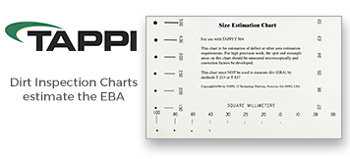 Search
Search
Use the search bar or filters below to find any TAPPI product or publication.
Filters
Content Type
Publications
Level of Knowledge
Collections
Journal articles

Magazine articles

Priorities for development of standard test methods to support the commercialization of cellulose nanomaterials, TAPPI Journal April 2019
ABSTRACT: With the growing number of producers and users of cellulose nanomaterials (CNMs), there is an increasing need to develop standard test methods to control production and quality of CNMs. In 2014, a Task Group was formed within the ISO Technical Committee 6 Paper, board and pulps to begin addressing the need for standards. This Task Group, TG 1, was tasked with reviewing existing standards and identifying the need for additional standards to characterize CNMs.In March 2018, TG 1 launched a survey to ask CNM producers around the world about the importance of having standard procedures to measure and quantify a variety of CNM properties, both physical and chemical. Producers were asked to identify the type(s) of CNM they produced and their scale of production, and to rank the properties for which they felt standard test methods were most important. In this paper, we summarize the survey responses and identify those properties of highest interest for producers of both cellulose nanocrystals (CNCs) and cellulose nano- and microfibril-based materials (CNFs/CMFs). Properties of importance can be divided into three broad groups: i) a standard has either been developed or is under develop-ment, ii) a currently used standard could be adapted for use with CNMs, or iii) no standard is currently available and further R&D and consultation with industry is needed before a suitable and well-validated standard can be developed. The paper also examines the challenges of developing new standard methods for some of the key properties—as well as the feasibility and limitations of adapting exiting standards—to CNMs.
Journal articles

Nanotechnology is Ready to Transform Our Industry", Paper360º September/October 2013
Nanotechnology is Ready to Transform Our Industry, Paper360º September/October 2013
Journal articles

Peculiarities of cellulose nanoparticles, TAPPI JOURNAL May 2014
Peculiarities of cellulose nanoparticles, TAPPI JOURNAL May 2014
Journal articles

International cooperation needed for nano standardization, Paper360° July/August 2011
International cooperation needed for nano standardization, Paper360º July/August 2011
Journal articles

Novel all-cellulose composite displaying aligned cellulose nanofibers reinforced with cellulose nanocrystals, TAPPI JOURNAL April 2011
Novel all-cellulose composite displaying aligned cellulose nanofibers reinforced with cellulose nanocrystals, TAPPI JOURNAL April 2011
Journal articles

Nanotechnology Functionality in Flexible Packaging; New Methods of Manufacturing, The PLACE, December 2006
Nanotechnology Functionality in Flexible Packaging; New Methods of Manufacturing, The PLACE, December 2006
Journal articles

Effects of different parameters on the morphology of electrospun cellulose acetate/polyaniline nanocomposite, TAPPI Journal February 2025
ABSTRACT: Cellulose is the most abundant naturally occurring polysaccharide. Its inherent mechanical stability, biocompatibility, biodegradability, and abundant hydroxyl groups available for derivatization provide benefits in the production of fiber-based materials such as conductive fibers. Cellulose derivatives, including cellulose esters such as cellulose acetate (CA), are readily generated in the fiber form following dissolution using a variety of solvents. Electrospinning is one of the emerging technologies with an outstanding ability to regenerate fibers in the nanoscale range. Polyaniline (PANI) is a conductive polymer that is popular for its high chemical stability, nontoxicity, good processability, and stable intrinsic redox state. This study explored the fabrication of a conductive PANI/CA nanocomposite through electrospinning. Working conditions, electrospinning variables, and solution parameters were established to produce coherent PANI/CA nanofibers. The effects of varying CA concentration, amount of PANI, molecular weight of CA, and feed flowrate on the morphology of the nanofibers were investigated.
Journal articles

Magazine articles

Editoral: Investing in the future: Writing and peer-reviewing for TAPPI Journal, TAPPI Journal July 2024
ABSTRACT: Those who actively participate in TAPPI realize how much there is to gain from the networking, educational resources, career development, and other opportunities that come with this involvement. One important opportunity is the ability to share your work and expertise with others in your field, and an excellent way to do this is by taking part in the TAPPI Journal peer-review process, either as an author or a reviewer or both.
Journal articles

Magazine articles

TAPPI Journal Summaries, Paper360º July/August 2019
TAPPI Journal Summaries, Paper360º July/August 2019
Journal articles

Magazine articles

A novel predictive method for filler coflocculation with cellulose microfibrils, TAPPI Journal November 2019
ABSTRACT: Different strategies aimed at reducing the negative impact of fillers on paper strength have been the objective of many studies during the past few decades. Some new strategies have even been patented or commercialized, yet a complete study on the behavior of the filler flocs and their effect on retention, drainage, and formation has not been found in literature. This type of research on fillers is often limited by difficulties in simulating high levels of shear at laboratory scale similar to those at mill scale. To address this challenge, a combination of techniques was used to compare preflocculation (i.e., filler is flocculated before addition to the pulp) with coflocculation strategies (i.e., filler is mixed with a binder and flocculated before addition to the pulp). The effect on filler and fiber flocs size was studied in a pilot flow loop using focal beam reflectance measurement (FBRM) and image analysis. Flocs obtained with cationic polyacrylamide (CPAM) and benonite were shown to have similar shear resistance with both strategies, whereas cationic starch (CS) was clearly more advantageous when coflocculation strategy was used. The effect of flocculation strategy on drainage rate, STFI formation, ash retention, and standard strength properties was measured. Coflocculation of filler with CPAM plus bentonite or CS showed promising results and produced sheets with high strength but had a negative impact on wire dewatering, opening a door for further optimization.





